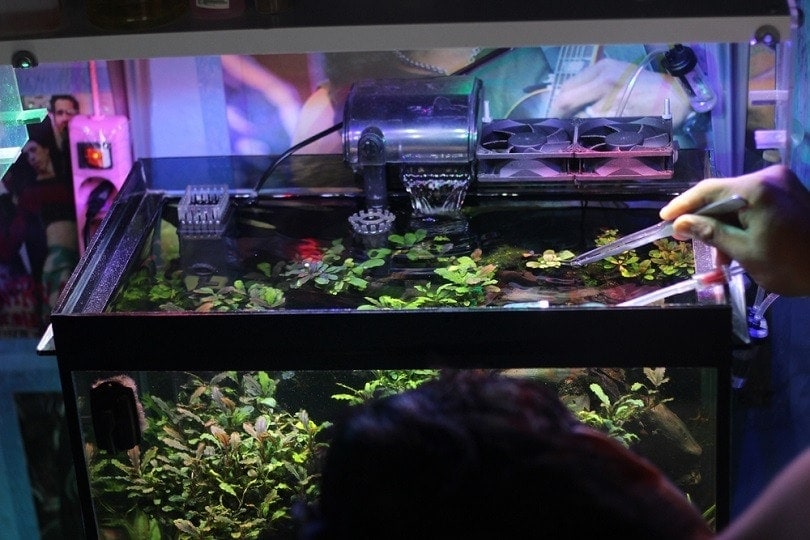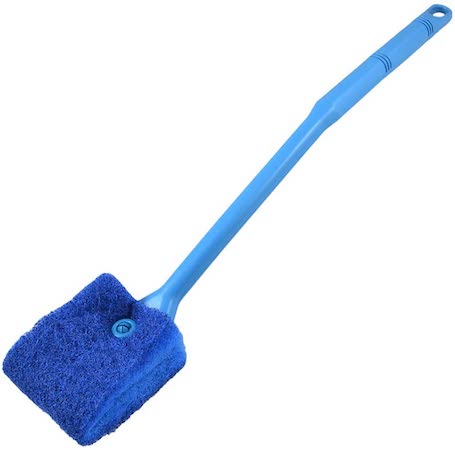How To Clean A Fish Tank – 10 Easy Steps

Updated on

Every beginning aquarist will clean their fish tank for the first time, and it’s natural to have questions and concerns. It might seem like a daunting task, but it’s actually quite easy if you follow some important steps.
Unfortunately, if you don’t know what you are doing, you will cause some serious damage to the ecosystem and to the fish themselves. There is a certain process that needs to be followed in order to safely clean your fish tank, and we’re here to spell it all out for you in this step-by-step guide.
Let’s get started!
The 10 Easy Steps to Clean a Fisk Tank
Cleaning your fish tank is not a very hard process. It does involve a fair amount of time, but the overall process is not very difficult.
Here are the steps you will need to follow in order to properly clean your aquarium:
1. Unplug heaters and filters.
The first thing that you need to do before beginning the cleaning process is to unplug all heaters and filters. If possible, remove them from the fish tank altogether. If you are using an air pump in your fish tank, unplug it and remove the air stone from the water (more on air stones on this article here).
2. Remove ornaments and artificial plants.
If you have any large ornaments or plastic plants in the fish tank, carefully and slowly remove them. Be as careful as possible when doing this because moving too quickly will stir up fish waste from the bottom.
An important thing to note is that you should never remove live plants from the water, especially if they have their roots set in the substrate. That will damage the live plants and maybe even kill them.

3. Clean off all algae.
This step involves removing all algae. Use a specialized brush or a glass scrubber to slowly move along the inside of the aquarium in order to remove all algae growth from the glass. If the algae growth is not very substantial and it’s not very stuck onto the glass, you can even use a clean face cloth to easily remove algae growth. Red algae is covered here.
Remember that you don’t want to press too hard on the glass or else you might damage or even break it.
4. Clean the substrate with a gravel siphon.
For this step, you will need a gravel siphon. Using the gravel siphon, remove approximately 25% of the water and place it in a bucket. Always remember that fish need to adjust to their new water. Therefore never remove more than 50% of the water when changing it.
Also, never tip the tank over, and use some kind of scoop to remove the water. Plus the water in your fish tank should be changed about twice per week, especially if you have a small fish tank.
When using the gravel syphon you want to move the gravel syphon through the substrate in a twisting circular motion to maximize the vortex and suction power of the syphon.
If you have a thick gravel or substrate layer, make sure to get past the top layer in order to get debris that is further down in the layer. Doing the bottom of the fish tank is the majority of the work, so make sure to get the floor when you do it.
You should also realize that moving too quickly with the gravel syphon will make a big mess, so when doing the circular movements, move slowly.

5. Clean plastic and rock ornaments.
Using that bucket of water that you removed from the aquarium, rinse and rub off all plastic and rock ornaments. This is in order to remove excessive algae growth and other unwanted microorganisms.
For this step, you will also want to rinse off the filter pad using the same water that you removed earlier.
6. Return everything to the fish tank.
Place everything including the filter, filter pad, cartridge, and all ornaments back into the fish tank. Make sure to place everything as it was before, of course unless you want to change the look of your fish tank.

7. Fill your bucket with fresh water.
Now it is time to empty that bucket of fish tank water that you removed from the tank before. Remember that an essential part of cleaning a fish tank is to do a water change.
This doesn’t mean that you need to change all of the water, just about 25% of it, or in other words, that same 25% as you removed in previous steps.
Fill your bucket with the same amount of tap water as you removed from the fish tank. Now it is time to take the thermometer inside of the fish tank and move it to the bucket of tap water.
You will want to adjust the fresh water to be the same temperature as the aquarium water that is still in the fish tank.
8. Condition your fresh water.
For this step, you will want to add water conditioner and aquarium salt to your bucket of fresh water. make sure to closely follow the directions on the packaging in order not to add too much or too little, both things which are not good.
If your aquarium is less than 4 months old, it is also recommended that you add living bacteria to your new bucket of water.

9. Mix the water and conditioners.
Use your hand or some other kind of mixing stick to swirl around the bucket water in order to help the salt and conditioners dissolve and mix into the water properly.
Never add aquarium salt or conditioners directly into the aquarium because that can be harmful to fish and may even cause death. The salt needs to be dissolved first!
10. Add the water to the aquarium.
Now it is time to dump the bucket of water you have prepared back into the aquarium. Be sure to dump the water back in slowly so as to not disturb the fish or any living plant matter. It may be water, but it is also quite heavy, especially if you dump it in all at once.
Also for this step, if you are using a power filter that hangs on the side of the aquarium, fill that up with some water as well.
Also, plug in the heater and filter once again in order to get the water back to the way it is supposed to be. Also place the ornaments back inside as well. Be sure to leave the lights off for a few hours as tank cleaning can cause the fish some stress, in which case darkness is a good thing.
Another thing that you need to do is to measure the temperature and the pH level of the water. Different fish need different water conditions so you need to properly adjust the water parameters in order to suit the needs of your fish.
It’s also worth looking into a protein skimmer or a UV sterilizer as they also help to keep your tank clean.

The 3 Recommended Tools To Clean Your Fish Tank
Cleaning your fish tank is made a lot easier if you have the proper tools. Here are a few of our recommendations that you can use to make cleaning your aquarium as easy as can be.
1. Python No Spill Clean and Fill Aquarium Maintenance System
This is a great tool that you can use to easily empty the water in the tank and add new water. Of course, you don’t want to completely change the water, only about 50% of it.
This tube system easily attaches to a faucet so you can add new water, and has one end to remove the water. It’s easy to use and barely takes any work.
This item also comes with a gravel tube so you can clean the gravel or substrate without any trouble at all. This product uses gravity to get the job done and does not involve any moving parts.
2. Gravel Cleaner for Aquarium
This is another great gravel cleaning tool. It is vacuum operated and uses slight suction to clean gravel and your aquarium floor from debris, bacteria, and other unwanted contaminants.
The hose is nice and long, uses a valve to start and stop water flow, and does a great job at removing debris and contaminants from your aquarium.
3. Uxcell Double Sided Sponge Cleaning Brush Cleaner
This is a great tool to have for cleaning an aquarium. It is a simple brush/scraping tool that has a long handle and will easily allow you to remove algae from the sides of your aquarium.
It’s a nice tool to have because it lets you get into all of those hard to get to spots like the corners. It is also guaranteed not to scratch the glass in your fish tank.
Conclusion
How to clean your fish tank is a question that anyone who is new to aquariums should ask. Clean it wrong or don’t do it properly and you may very well end up killing the fish or severely damaging the plants in the tank.
You might also find this post helpful on removing Chlorine from your tank.
Always keep things like the pH level of the water in mind as well as the nutrients and bacteria present. Different fish require different water conditions, something that you need to know before changing water or cleaning the fish tank.
See Also:
- How To Keep A Saltwater Tank Clean – 5 Essentials!
- 10 Best Aquarium Vacuums For Sand – Reviews & Top Picks
Featured Image Credit: hedgehog94, Shutterstock















